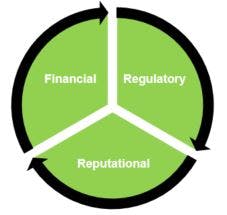

The impact COVID-19 and other factors have on college and university athletic programs
The coronavirus (COVID-19) has affected higher education institutions both fundamentally and financially. In March 2020, as colleges and universities across the country transitioned to a remote learning environment, intercollegiate athletic seasons were cut short or cancelled entirely.
The decision to cancel competition intensified most athletic departments’ pre-existing struggle for financial stability. On an annual basis, the National Collegiate Athletic Association (NCAA) distributes funds to its member schools. Most of this money comes from the television and marketing rights as well as ticket sales for the Division I Men’s Basketball Championship. This, combined with decreased revenues (e.g., from tuition, fees and other revenue generating sports that were likely subsidizing others) and stagnant or increasing costs, have compelled leaders to make some difficult and unpopular decisions related to cutting athletic programs.
Programmatic cuts
Although cuts to athletic programs are not unique to the COVID era, colleges and universities of all sizes are considering changes to their athletic programs as a result of COVID-19 and other variables within the industry that have been exacerbated by the pandemic. Recently and in the current higher education athletic program landscape, institutions make cuts to programs for a variety of reasons, although financial pressures remain the primary driving force behind such decisions.
Potential risks to be aware of
It is important to understand the possible risks related to cutting a collegiate athletic program. Consider the following when making these strategic decisions.
Financial risks:
- Impacts to the school’s ability to use and/or generate gift funds and endowed scholarships
- Decline in future enrollment and tuition revenue
- Reduction in funds distributed by the NCAA
- Decrease in special assistance funds (e.g., Pell Grant disbursements)
Regulatory risks:
- Non-compliance with Title IX and NCAA regulations
- Misrepresentation in annual reports to the Department of Education on athletic program participation, staffing and revenue and expenses for men’s and women’s teams
Reputational risks:
- Unfavorable public perception from students, parents, alumni, prospective students, sports fans and the general public
- Negative publicity from social media and news outlets
Key considerations
Eliminating any collegiate team sport is going to be unpopular. Period. Leaders should consider doing the following before making the decision to cut a program:
- Define the long-term strategy for athletics: How do intercollegiate sports fit into the institution’s mission, vision and organization-wide strategy?
- Develop and implement a process and documentation to provide clarity on budgets and to monitor program spending. This should include established metrics and red flag indicators, and clearly identify who is responsible for budgeting and monitoring team spend.
- Outline the decision making process for keeping or cutting teams, including:
- Trend analysis: Does the program have a history of winning?
- Other means of support: Can the institution leverage facility rentals for revenue or offer camps and clinics?
- Impact on development, advancement and stewardship: How can the department/program have proactive conversations with gift officers and stewards?
- A process for walking back cuts
- Impact on recruitment and enrollment: What percentage of your student body are athletes? How could cuts impact future enrollment?
- Plans for communicating planned cuts: How are program stakeholders included in the conversation? Are they given the opportunity to identify an alternative solution? - Create a strategic approach to conversations: Transparency is key! Make sure to work with the program, make the process collaborative and ensure voices are heard.


